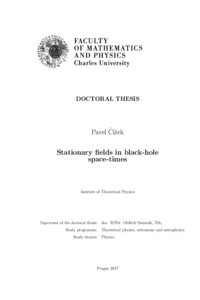Stationary fields in black-hole space-times
Stacionární pole v prostoročasech černých děr
rigorózní práce (UZNÁNO)

Zobrazit/
Trvalý odkaz
http://hdl.handle.net/20.500.11956/95537Identifikátory
SIS: 200286
Kolekce
- Kvalifikační práce [10926]
Autor
Vedoucí práce
Fakulta / součást
Matematicko-fyzikální fakulta
Obor
Teoretická fyzika
Katedra / ústav / klinika
Ústav teoretické fyziky
Datum obhajoby
1. 3. 2018
Nakladatel
Univerzita Karlova, Matematicko-fyzikální fakultaJazyk
Angličtina
Známka
Uznáno
Motivována jak astrofyzikálními modely černých děr s akrečním diskem, tak čistým teoretickým zájmem, se tato práce zabývá tenkými disky obklopujícími černou díru. Jsou zde rozpracovány dvě metody jak dostat stacionární osově sy- metrické řešení Einsteinových rovnic. První z nich je použití poruchového rozvoje. Vycházejíc z článku Will (1974) jsou zde dopočítány Greenovy funkce v uzavřené formě jejichž užitím je možno dostat lineární perturbaci Schwarzschildovy černé díry kompaktním diskem. Druhá část přistupuje k témuž problému použitím Be- linského-Zacharovy metody. Ukazuje se, že "superponování" Bachova-Weylova ringu a černé díry (tj. přidáním dvou solitonů k ringu) vede k nefyzikálním sta- cionárním metrikám. Jedinou výjimkou je stacionární případ, kdy se porařilo celou metriku vyjádřit v uzavřené formě. 1
Motivated by modelling of astrophysical black holes surrounded by accretion structures, as well as by theoretical interest, we study two methods how to ob- tain, within stationary and axisymmetric solutions of general relativity, a metric describing the black hole encircled by a thin ring or a disc. The first is a suitable perturbation of a Schwarzschild black hole. Starting from the seminal paper by Will (1974), we showed that it is possible to express the Green functions of the problem in a closed form, which can then be employed to obtain, e.g., a reason- able linear perturbation for a black hole surrounded by a thin finite disc. In the second part we tackle the same problem using the Belinskii-Zakharov generating algorithm, showing/confirming that in a stationary case its outcome is unphysi- cal, yet at least obtaining a modest new result for the (static) "superposition" of a Schwarzschild black hole with the Bach-Weyl ring. 1
